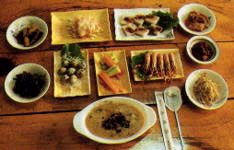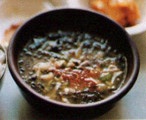Traditional Cheju Cuisine
 |
Chari-hoiThis dish is rich in oils, protein and calcium and is most often served in the summer. The Chari is a small perch-like fish, dark in color, which is caught by net along the coast of the island from May through August, although islanders claim that the fish taste best when they are caught around the time of barely harvest. |
Chonbok-jukThe flesh and shells of the abalone were treasured in ancient Korea and offered as tribute to the royal court during the Koryo (918-1392) and Yi (1392-1910) Dynasties. Today, abalone is very rare and the most expensive fo Cheju's shellfish. Chonbok-juk is a favorite of the Cheju people, especially in the summer time. The dish is supposedly good for pregnant women, people who overweight and people suffering from scelrosis of the liver. The Songsanpo are is known for its abalone. |
 |
 |
Mom-gukThis soup is made from pig intestines, dried mom, a type of sea weed, and the broth creating when the bones and intestines of the pig are boiled. This dish is a must at formal occasions, such as weddings or family memorials. |
Oktom-gui ChongsikThe oktom is only caught in the waters near Japan and Cheju. The nutritional value of the bones, skin and eyes is extremely high, making oktom an excellent meal for the old and the ill. |
 |
 |
Omegi-sulOmegi-sul is a favorite of older Cheju islanders. A lightly distilled liquor made from glutinous millet and with an alcohol level of approximately 17-18 percent. Omegi-sul is a tasty reminder of Cheju Island's past when white rice was unavailable, and only barely, millet and other small grains were grown on the isalnd. Some people believe that one can best understand the Cheju people by sampling their various wines as one travels around the island. |
Raw PigletThis dish is believed to help counteract the affects of alcohol, sustaining high energy levels in the body, overcoming fatigue and promoting recovery from illness. When eaten for these health purposes, water is not added to the chopped meat. |
 |
 |
Songge-gukSince songge, or sea urchin, is rich in protein, vitamins and minerals, it serves as a popular health food for anemic people. This dish si slightly sweet and salty. Today, other sea products are often added for flavor. |
Information obtained from Chejudo Tourist Association, Cheju Tour Guide.
Last updated by Chun HyongJun on March 27, 1997.